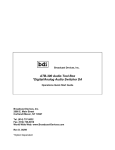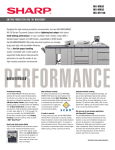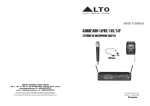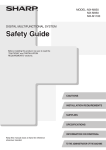Download Cambridge Audio DAB300 Specifications
Transcript
Broadcast Devices, Inc. DAB-300 Digital Audio Broadcast *Digital/Analog Audio Switcher DA Operations Quick Start Guide Broadcast Devices, Inc. 2066 E. Main Street Cortlandt Manor, NY 10567 Tel. (914) 737-5032 Fax. (914) 736-6916 World Wide Web: www.Broadcast-Devices.com Rev C 01/10 *Option Dependent Table of Contents I. Basic Description 3 II. DAB-300 Operational Description 3 III. Remote Control Operation 3-4 IV. Input Mode Selection Menu System 4-5 V. Audio I/O Connector Diagrams 6-7 VI. Remote Control Connector Diagrams 8-9 VII. DAB-300-DAS Block Diagram 10 VIII. Frame Rate Conversion Switch Selection 11 IX. Warranty 12 2 I. Basic Description The DAB-300 is a dual 4-channel audio switch intended for simultaneously switching parallel program audio feeding analog and digital broadcast transmitters where synchronous timing such as in IBOC operations is important to maintain. It functions similar to a 4 position dual pole switch in that when audio to the analog transmitter is switched, the output feeding the digital transmitter is switched to the corresponding program source for the analog transmitter. Automatic silence detection may be enabled to switch both analog and digital program feeds if either becomes silent for a period which exceeds the user defined interval. The DAB-300 can be ordered for four or eight inputs. The inputs can be AES3 digital and/or analog L/R and composite base band depending on model. II. DAB-300 Operational Description The DAB-300 may be placed in the manual switching mode by pressing either the left or right arrow key. The source selected will begin to flash. Select the desired input using the up and down arrow keys. When the desired input channel is flashing press the green enter key to accept the selection and switch to the selected input. If a channel is not selected within 1 minute the DAB-300 will exit the manual switching mode automatically. Note that the inputs will be selected in pairs. If Input 1 is selected to feed the analog transmitter, Input 5 will be directed to the digital transmitter. The other inputs (2/6, 3/7 and 4/8) are paired similarly. III. REMOTE CONTROLLED OPERATION The DAB-300 provides remote control to select between inputs and to enable/disable remote operation. Open collector status outputs are provided to indicate the currently selected input channel. These outputs are capable of sinking up to 100ma and are rated at a maximum of 30v DC. Remote Channel Selection: The DAB-300 DAS provides 4 channel selection inputs and 4 channel status outputs on the remote control DB-25 connector. Each output channel pair (1-4) is controlled via its respective channel select pin (GPI 0-3) and provides a status output (GPO 0-3) which reflects which of the 4 input pairs (1/5 through 4/8) is currently selected. A momentary 3 closure between the GPI pin corresponding to the desired input pair and control common will cause that input pair to be routed to that output. Likewise the open collector status outputs will float for the unselected channel pairs and be pulled low for the status output corresponding to the selected input pair. Refer to section VI. Remote Control Connector designation chart on page 9 for connection information. IV. Input Mode Selection Menu Operation The DAB-300 inputs can be configured for mode of operation on an individual basis. Stereo, Mono Left, Mono Right, L+R and Stereo Swap can be configured from the front panel. Use mono left and mono right to fill in a missing channel. For example; choosing mono left will take a signal only input on the left channel and apply it to both channels at the output of the unit. Use L+R to create a monaural input from a stereo source. To select the input mode push F4 once. The display will indicate that you are in the INPUT MODE SELECTION menu. Select the input channel pair (1-8) using the up and down arrow keys. The left and right arrow keys are then used to select between the following modes: Press F4 once: Input Mode Selection Pushing the up arrow/down allows you to select the input channel to be changed: Pushing the left/right arrow buttons allows selection of the following input modes: OFF Stereo - Factory Default LR Swap - L/R Channels Swapped Mono L - L input fed to both L & R outputs Mono R - R input fed to both L & R outputs L + R - L & R inputs are summed and fed to both L & R outputs. The input mode is automatically saved when selected. To exit this menu press the F1 key to return to the main menu. Press F4 twice: Input Invert Control – Phase Inversion Pushing the up arrow/down allows you to select the input channel to be changed: Pushing the left/right arrow buttons allows selection of the following input modes: Normal Invert Left Invert Right Note: Phase inversion is Left or right but not both simultaneously. 4 Input Invert Control modes are automatically saved when selected. To exit this menu press the F1 key to return to the main menu. Press F4 three times to enter Input Gain Control menu Pushing the up arrow/down allows you to select the input channel to be changed: Pushing the left/right arrow buttons allows you to adjust gain in one dB increments +/10 dB Press F4 four times and the display will indicate Output Gain Control Pushing the up arrow/down allows you to select the output channel to be changed: Pushing the left/right arrow buttons allows you to adjust gain in one dB increments +/10 dB Factory default for input and output gain controls is 0 dB. When factory default gains are used AES3 I/O is unity. When AES3 inputs are output to an analog channel the analog output will correspond to –10 dB below full scale AES3 input when AES3 input is nominal – 10 dB below full scale. DAB-300 Factory Default Recovery As with any programmable device, it is possible that the user would like to quickly return to the “factory default” settings. To return the DAB-300 to its factory configuration remove AC power to the unit. While holding the red “X” key, restore AC power until the display indicates “FACTORY DEFAULT”. The default condition is such that outputs 1 through 4 are fed by input 1 and outputs 5 through 8 are fed by input 5. V. Automatic Silence Detection Setup Push F3 once to enter the silence detection setup menu. Doing so presents the user with a dialog which sets the silence detection interval. The factory default silence detection time is 60 seconds. Values ranging from 10 to 600 seconds may be selected using the up and down arrow keys. Broadcast Devices strongly suggests that silence detection intervals of less than 60 seconds be tested carefully to verify that normal program content does not cause undesirable switching. Push F3 a second time to select the silence detection threshold level. This is the audio level below which the DAB-300 considers the input to be silent (inactive). The factory default silence threshold is “5”. This level may be changed using the up and down arrow keys. 5 Push the F3 key a third time to enable / disable the auto-return function and to set the auto-return time. The auto-return function will cause the DAB-300 to return to the channel pair which was selected prior to a loss of audio detection and subsequent autoswitching. Using the up and down arrow keys intervals ranging from 1-10 minutes may be selected or the auto-return function may be disabled. A 4th press of the F3 key will move to the Audible Alarm Config menu. The audible alarm will sound when a loss of audio has been detected if enabled. Use the up and down arrow keys to enable or disable the audible alarm. Pressing the F3 key a 5th time will move to the AUX RELAY CONFIG menu. Using the up and down arrow keys the AUX RELAY may be set to either close and remain closed or to issue a momentary 1 second closure upon loss of audio. Using the momentary function can be useful in applications such as starting a CD player to be used as a backup program audio source. Press F1 to exit the silence detection setup dialogs. VI. Audio I/O Connections DAB-300 Audio Connections DIGITAL AUDIO I/O 1 14 2 15 3 16 4 17 5 18 6 19 7 20 8 21 9 22 10 23 11 24 12 25 13 DB-25 ANALOG AUDIO - INPUT & OUTPUT PINOUTS ARE IDENTICAL AESOUTP4 AESOUTN4 CH4 OUT AESINP4 AESINN4 CH4 IN AESOUTP3 AESOUTN3 CH3 OUT AESINP3 AESINN3 CH3 IN AESOUTP2 AESOUTN2 CH2 OUT AESINP2 AESINN2 CH2 IN AESOUTP1 AESOUTN1 CH1 OUT AESINP1 AESINN1 CH1 IN 1 14 2 15 3 16 4 17 5 18 6 19 7 20 8 21 9 22 10 23 11 24 12 25 13 CH8P CH8N CH8 RIGHT CH7P CH7N CH8 LEFT CH6P CH6N CH 7 RIGHT CH5P CH5N CH 7 LEFT CH4P CH4N CH 6 RIGHT' CH3P CH3N CH 6 LEFT CH2P CH2N CH5 RIGHT CH1P CH1N CH5 LEFT DB-25 DAB-300 AUDIO INPUT MAPPING MODEL DEPENDENT 6 INPUT CHANNEL 1 2 3 4 5 6 7 8 TYPE DIGITAL DIGITAL DIGITAL DIGITAL ANALOG ANALOG ANALOG ANALOG LOCATION AES 1 AES 2 AES 3 AES 4 ANALOG IN 1-2 (L/R) ANALOG IN 3-4 (L/R) ANALOG IN 5-6 (L/R) ANALOG IN 7-8 (L/R) AES and Analog L/R Input Version INPUT CHANNEL 1 2 3 4 5 6 7 8 TYPE DIGITAL DIGITAL DIGITAL DIGITAL ANALOG ANALOG ANALOG ANALOG LOCATION AES 1 AES 2 AES 3 AES 4 COMPOSITE BASE BAND 1 COMPOSITE BASE BAND 2 COMPOSITE BASE BAND 3 COMPOSITE BASE BAND 4 AES and Composite Input Version INPUT CHANNEL 1 2 3 4 5 6 7 8 TYPE ANALOG ANALOG ANALOG ANALOG ANALOG ANALOG ANALOG ANALOG LOCATION ANALOG IN 1-2 (L/R) ANALOG IN 3-4 (L/R) ANALOG IN 5-6 (L/R) ANALOG IN 7-8 (L/R) COMPOSITE BASE BAND 1 COMPOSITE BASE BAND 2 COMPOSITE BASE BAND 3 COMPOSITE BASE BAND 4 Analog L/R and Composite Base Band Input Version 7 VI. Remote Control Connections DAB-300 Remote Connections REMOTE P1 1 14 2 15 3 16 4 17 5 18 6 19 7 20 8 21 9 22 10 23 11 24 12 25 13 DB-25 FEMALE INPUT COM INPUT COM INPUT COM INPUT COM INPUT COM INPUT COM INPUT COM +12V CHASSIS SELECT-INPUT1/5 STATUS- 1/5 ACTIVE SELECT-INPUT2/6 STATUS- 2/6 ACTIVE SELECT-INPUT3/7 STATUS- 3/7 ACTIVE SELECT-INPUT4/8 STATUS- 4/8 ACTIVE COMP DECODE 1 COMP DECODE 2 COMP DECODE 3 COMP DECODE 4 REMOTE P2 1 14 2 15 3 16 4 17 5 18 6 19 7 20 8 21 9 22 10 23 11 24 12 25 13 K1-COM K1-NC K1-NO K2-COM K2-NC K2-NO FAULT DETECTED RELAYS AUTO AUTO-COM MANUAL MANUAL-COM REMOTE ENABLE REMOTE ENABLE COM FAULT RESET FAULT RESET COM REMOTE INPUTS CHASSIS DB-25 FEMALE Notes: 1. Status outputs are open collector Darlington transistors capable of sinking 100ma @ 30v DC. 2. Select and remote inputs are momentary closures with internal 4.7K pullup resistors to 5v DC. 3. Any of the first four AES or analog L/R inputs can be substituted for composite input by strapping the respective COMP DECODE pin to INPUT COM as illustrated in the above figure. Then strapped, the normal 1-4 input will be substituted for a composite input 1-4. 8 K1 AUDIO ALARM RELAY 1 +5V CIT J1031C5VDC.15S K2 AUDIO ALARM RELAY 2 +5V CIT J1031C5VDC.15S K3 AUDIO ALARM RELAY 3 +5V CIT J1031C5VDC.15S K4 AUDIO ALARM RELAY 4 AUDIO ALARM RELAY K1 K2 K3 K4 K5 K6 5 K7 K8 +5V CIT J1031C5VDC.15S K5 +5V AUDIO ALARM RELAY 6 AUDIO ALARM CIT J1031C5VDC.15S K6 +5V 1 14 2 15 3 16 4 17 5 18 6 19 7 20 8 21 9 22 10 23 11 24 12 25 13 1 14 2 15 3 16 4 17 5 18 6 19 7 20 8 21 9 22 10 23 11 24 12 25 13 CIT J1031C5VDC.15S DB25 Female DB25 Male (User Supplied) K7 AUDIO ALARM RELAY 7 +5V CIT J1031C5VDC.15S K8 AUDIO ALARM RELAY 8 +5V CIT J1031C5VDC.15S DAB-300 Audio Alarm Connection The DAB-300 provides audio failure alarm status contacts for each of the eight inputs. Each relay is held closed when audio is present. If audio is removed for at least five seconds the respective relay will de energize. If audio is restored for at least five seconds the respective channel relay will re energize. Relay 1-8 provide audio status for inputs 1-8 respectively 9 VII. Basic Block Diagram of DAB-300 DIGITAL AUDIO I/O BOARD 1 PGM AUDIO PGM AUDIO PGM AUDIO PGM AUDIO DIGITAL AUDIO I/O BOARD 1 S1A INPUT 1 INPUT 2 INPUT 3 INPUT 4 SILENCE DETECT 1-4 DIGITAL AUDIO I/O BOARD 2 PGM AUDIO PGM AUDIO PGM AUDIO PGM AUDIO INPUT 5 INPUT 6 INPUT 7 INPUT 8 OUT 1 OUT 2 OUT 3 OUT 4 DIGITAL AUDIO I/O BOARD 2 S1B SILENCE DETECT 5-8 DIGITAL DIGITAL DIGITAL DIGITAL GPIO-0 SELECT 1 GPIO-1 SELECT 2 DIGITAL DIGITAL DIGITAL DIGITAL DAS-300 CPU GPIO-2 SELECT 3 GPIO-3 SELECT 4 1 OUT 5 OUT 6 OUT 7 OUT 8 VIII. Frame Rate Conversion Switch Selection The DAB-300 has active frame rate conversion on all AES3 digital inputs. The unit can accept sample rates from 8 KHz to 96 KHz. The frame rate converter then up or down converts the sample rate to the selected sample rate. The DAB-300 is capable of outputting 32, 44.1 or 48 KHz sample rates. The factory default sample rate is 44.1 KHz. To change the sample rate to either 32 or 48 KHz refer to the diagram below. The sample rate converters are located on the AES I/O board. Locate S1 and change SR0, SR1 according to the chart below. Do not adjust any other DIP switch setting as this will result in incorrect operation of the DAB-300. Correct DIP switch settings are provided for convenience. 4 3 2 J1 J2 J2 J4 J2 J4 J1 J3 J1 J3 A1 5 J5 1 A0 A1 A2 INT M/S TDM SR0 SR1 32 KHz Output Sample Rate 7 6 5 4 3 2 IDC DB-25 S1 1 DSP BOARD P5 S1 ON A0 A1 A2 INT M/S TDM SR0 SR1 44.1 KHz Output Sample Rate P8 S1: 1-4-5 = ON Hardw ire d P7 P3 S1 8 7 6 5 4 3 2 1 REV B FP ONLY ON A0 A1 A2 INT M/S TDM SR0 SR1 48 KHz Output Sample Rate GPIO BOARD J2 ON 8 A2 6 J2 A0 7 INT AES AUDIO I/O BOARD S1 8 ON S1 AES I/O Board Switch Settings ANALOG AUDIO OUT BOARD S1 All On S1 On J4 FRONT PANEL REV C AND HIGHER AS VIEWED FROM TOP W/ FRONT PANEL HINGED DOWN P5 P1 FRONT PANEL REV B AS VIEWED FROM TOP W/ FRONT PANEL HINGED DOWN P6 P5 1 P1 IX. Warranty Broadcast Devices, Inc. products are warranted against failure due to faulty materials or workmanship for a period of one year from the date of shipment to the ultimate user. The warranty covers repair or replacement of defective parts at the factory, provided the unit has been returned prepaid by the user. All shipments to the factory shall have affixed to the outside of the container a return authorization number obtained from the factory. The above warranty is void if the unit has been modified by the user outside of any recommendations from the factory or if the unit has been abused or operated outside of its electrical or environmental specifications. If customer conducted field tests suggest that the unit may be faulty, whether or not the unit is in warranty, a full report of the difficulty should be sent to Broadcast Devices, Inc. factory at Cortlandt Manor, New York. The office may suggest further tests or authorize return for factory evaluation. Units sent to the factory should be well packed and shipped to Broadcast Devices, Inc. 2066 E. Main Street, Cortlandt Manor, NY 10567. Remember to affix the R.A. number to the outside of the carton. Any packages received without such R.A. number will be refused. Note: freight collect shipments will also be refused. When the unit has been received, inspected and tested, the customer will receive a report of the findings along with a quotation for recommended repairs, which are found falling outside of the standard warranty. Units returned for in-warranty repairs, which are found not to be defective will be subject to an evaluation and handling charge. In-warranty units will be repaired at no charge and returned via prepaid freight. Out-of-warranty units needing repair require a purchase order and will be invoiced for parts, labor, and shipping charges. When ordering replacement part, always specify A) Part Description, and Quantity; B) Date of Purchase, Where Purchased; C) Any Special Shipping Instructions. Always specify a street address, as shipping companies cannot deliver to a postal box. Broadcast Devices, Inc. is not responsible for any other manufacturer’s warranty on original equipment. Nor are we responsible for any failure, damage, or loss of property that may occur due to the installation or operation of our equipment outside of recommended specifications. 1 Broadcast Devices, Inc. reserves the right to change materials, specifications, and features from time to time. www.broadcast-devices.com Broadcast Devices, Inc. 2066 E. Main Street Cortlandt Manor, NY 10567 Email: [email protected] (914) 737-5032 Tel. 1 (914) 736-6916 Fax.

















